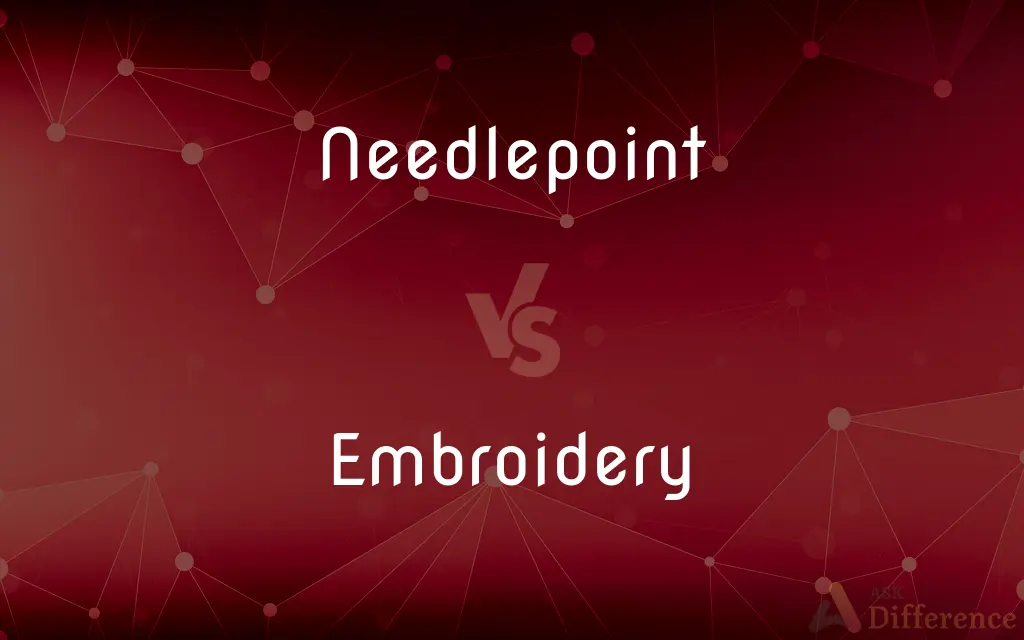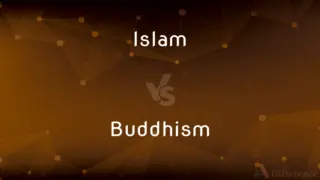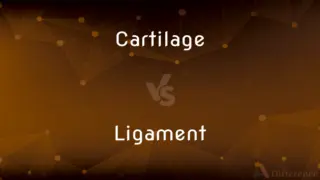Needlepoint vs. Embroidery — What's the Difference?
Edited by Tayyaba Rehman — By Urooj Arif — Updated on May 13, 2024
Needlepoint involves stitching on open-weave canvas, primarily using tent stitches; embroidery encompasses various styles and stitches on different fabrics.

Difference Between Needlepoint and Embroidery
Table of Contents
ADVERTISEMENT
Key Differences
Needlepoint uses a stiff open-weave canvas, where stitches cover the entire surface, providing a dense and durable finish. Embroidery, on the other hand, can be done on any fabric, ranging from delicate silks to heavy canvas, and may not cover the entire fabric surface.
While needlepoint typically involves the use of wool or yarn, making it suitable for heavy items like upholstery and rugs, embroidery uses materials such as silk, cotton, or metallic threads, which cater to both sturdy and fine fabric applications.
Needlepoint is characterized by its predominant use of the tent stitch, a simple diagonal stitch that forms a half cross stitch. Embroidery employs a variety of stitches such as back stitch, chain stitch, and satin stitch, offering a wide range of textures and patterns.
In needlepoint, the artist works within a rigid grid-like structure due to the nature of the canvas, which can limit design complexity. Whereas embroidery offers more flexibility in terms of stitch placement and design, allowing for intricate patterns and detailed imagery.
On the other hand, needlepoint projects often take longer to complete due to the coverage of large areas with dense stitching. Embroidery can be quicker depending on the type of stitch used and the extent of the fabric covered.
ADVERTISEMENT
Comparison Chart
Base Material
Stiff open-weave canvas
Various fabrics (silk, cotton, canvas)
Thread Type
Primarily wool or yarn
Silk, cotton, wool, metallic threads
Stitch Type
Mainly tent stitches
Variety (back, chain, satin, etc.)
Coverage
Full coverage of the canvas
Partial or full, depending on design
Design Complexity
Limited by grid structure
High flexibility and detail possible
Compare with Definitions
Needlepoint
A form of counted thread embroidery in which yarn is stitched through a canvas.
She completed a needlepoint cushion cover with a floral design.
Embroidery
Utilizes a variety of stitches to achieve texture and pattern.
She learned several embroidery stitches, including French knots and feather stitch.
Needlepoint
Often used to create decorative wall hangings and upholstery.
The antique chair was upholstered in a rich, needlepoint fabric.
Embroidery
The art of decorating fabric with needle and thread.
Embroidery embellishments on her dress were hand-stitched.
Needlepoint
Known for its durability and thickness.
Needlepoint rugs are popular for their long-lasting quality.
Embroidery
Features in traditional and modern fashion.
Embroidery techniques have evolved but still remain a staple in textile art.
Needlepoint
Generally requires the use of a special type of canvas.
She purchased needlepoint canvas for her new project.
Embroidery
Often used for personalizing garments.
His initials were embroidered on the cuffs of his shirt.
Needlepoint
Needlepoint is a type of canvas work, a form of counted thread embroidery in which yarn is stitched through a stiff open weave canvas. Traditionally needlepoint designs completely cover the canvas.
Embroidery
Embroidery is the craft of decorating fabric or other materials using a needle to apply thread or yarn. Embroidery may also incorporate other materials such as pearls, beads, quills, and sequins.
Needlepoint
Decorative needlework on canvas, usually in a diagonal stitch covering the entire surface of the material.
Embroidery
The act or art of embroidering.
Needlepoint
A type of lace worked on paper patterns with a needle. Also called point lace.
Embroidery
Ornamentation of fabric with needlework
A pillow decorated with embroidery.
Needlepoint
(uncountable) A craft involving pulling yarn, thread, or floss through a canvas mesh to produce a decorative design.
Embroidery
A piece of embroidered fabric.
Needlepoint
(countable) An object made using that craft.
Embroidery
Embellishment with fanciful details.
Needlepoint
To produce a decorative design by this means.
Embroidery
The ornamentation of fabric using needlework.
Needlepoint
Lace worked with a needle in a buttonhole stitch on a paper pattern
Embroidery
A piece of embroidered fabric.
Needlepoint
Embroidery consisting of allover embroidered canvas resembling tapestry
Embroidery
The elaboration of an account etc. with details, especially when fictitious.
Needlepoint
Typically executed with tent stitches.
Needlepoint kits usually include instructions for mastering the tent stitch.
Embroidery
Needlework used to enrich textile fabrics, leather, etc.; also, the art of embroidering.
Embroidery
Diversified ornaments, especially by contrasted figures and colors; variegated decoration.
Fields in spring's embroidery are dressed.
A mere rhetorical embroidery of phrases.
Embroidery
Elaboration of an interpretation by the use of decorative (sometimes fictitious) detail;
The mystery has been heightened by many embellishments in subsequent retellings
Embroidery
Decorative needlework
Embroidery
Can be done by hand or machine.
Modern embroidery machines can replicate complex patterns quickly.
Common Curiosities
What is needlepoint?
Needlepoint is a type of embroidery that uses a grid-based canvas and is typically covered entirely with stitches.
What is embroidery?
Embroidery is the craft of decorating fabric or other materials using a needle to apply thread or yarn.
Which is more durable, needlepoint or embroidery?
Needlepoint tends to be more durable due to its heavy use of wool and full coverage, making it ideal for items like rugs and upholstery.
What are the most common stitches used in needlepoint and embroidery?
Needlepoint predominantly uses the tent stitch, while embroidery includes stitches like chain, satin, and back stitch.
Are there any famous historical examples of embroidery?
Examples include medieval European tapestries and traditional Japanese kimonos with detailed embroidery.
Can needlepoint be considered a form of embroidery?
Yes, needlepoint is a specific type of embroidery that focuses on covering a woven canvas entirely with stitches.
How do the materials used in needlepoint and embroidery differ?
Needlepoint generally uses thicker threads, such as yarn or wool, whereas embroidery can include a wide range of threads like silk, cotton, and synthetic materials.
Is needlepoint or embroidery better for intricate designs?
Embroidery is generally better for intricate designs due to its flexibility in stitch types and placement.
How long does it typically take to complete a needlepoint project compared to an embroidery project?
Needlepoint projects can take longer due to the detailed and extensive nature of the stitch coverage; embroidery might be quicker depending on the design complexity.
Are there any famous historical examples of needlepoint?
Historic examples include the Bayeux Tapestry and upholstered furniture from the Victorian era.
What are the basic tools needed for needlepoint?
The basic tools include needlepoint canvas, needles, and yarn or thread.
Can embroidery be automated?
Yes, embroidery can be performed by machines, which can replicate detailed designs more quickly and efficiently than hand stitching.
How has the use of needlepoint and embroidery evolved over time?
Both forms have evolved from basic utility and decoration to intricate art forms and modern design elements in fashion and home decor.
What type of projects are best suited for needlepoint?
Projects that require durability and are decorative, such as upholstery and wall hangings, are suited for needlepoint.
What are the basic tools needed for embroidery?
Basic embroidery requires needles, thread, and fabric, and sometimes a hoop to maintain fabric tension.
Share Your Discovery

Previous Comparison
Islam vs. Buddhism
Next Comparison
Cartilage vs. LigamentAuthor Spotlight
Written by
Urooj ArifUrooj is a skilled content writer at Ask Difference, known for her exceptional ability to simplify complex topics into engaging and informative content. With a passion for research and a flair for clear, concise writing, she consistently delivers articles that resonate with our diverse audience.
Edited by
Tayyaba RehmanTayyaba Rehman is a distinguished writer, currently serving as a primary contributor to askdifference.com. As a researcher in semantics and etymology, Tayyaba's passion for the complexity of languages and their distinctions has found a perfect home on the platform. Tayyaba delves into the intricacies of language, distinguishing between commonly confused words and phrases, thereby providing clarity for readers worldwide.













































